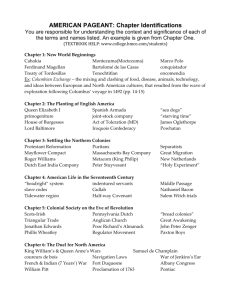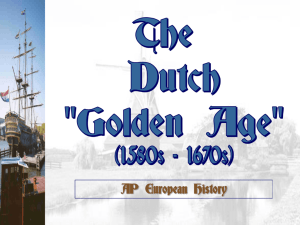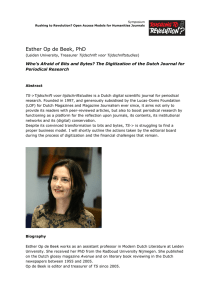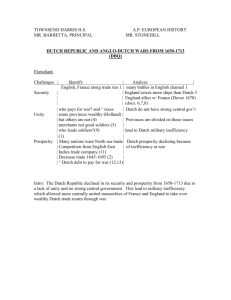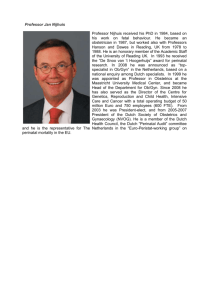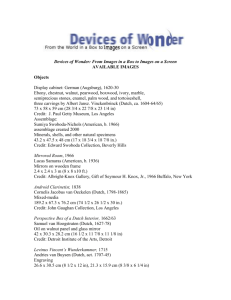The Dutch GOlden Age
advertisement
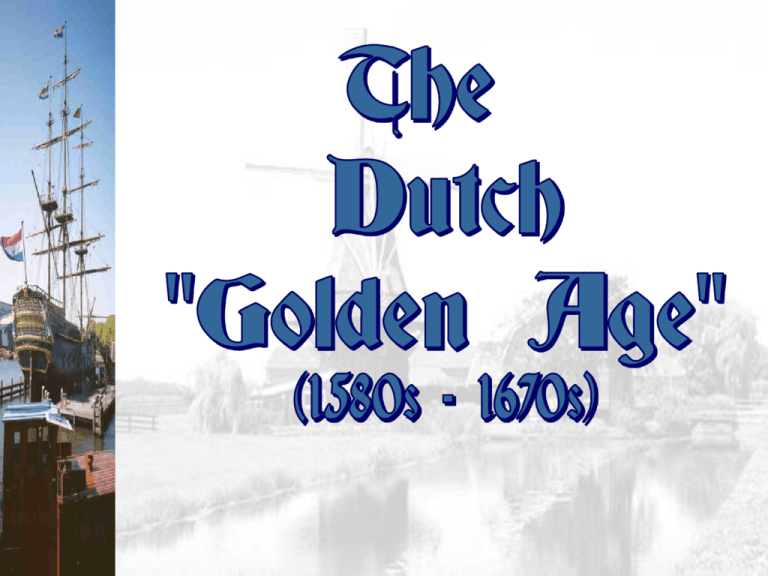
The Netherlands: The “Low Country” Dutch Architecture Patrician homes along the canal in Leiden Row houses & Catholic “hidden” Church, Amsterdam Upper-class Homes, Amsterdam 1600s Why was the Netherlands the best place to live in Europe in the 17th c.? 17th c: The “Dutch” Century A fiercely republican form of gov’t Religious toleration Protestants, Catholics & Jews lived together peacefully Urban society more people lived in cities than any other area of Europe. 1st capitalist economy (thriving & stable) Amsterdam Europe’s financial capital “Golden Age” of artists and thinkers. Dutch universities were centers of intellectual life, progressive ideas & scientific achievement. Dutch Society Granaries with enough surplus for one year (Amsterdam & Rotterdam) Generally higher salaries than in any other parts of W. Europe. Even women had higher wages. “Protestant work ethic.” Thrift and frugality. Had the highest standard of living in Europe! Had a commercial empire that spanned the globe! The Dutch Republic (Federation) Loose confederation of seven independent & strong states The Dutch Republic: A Flow Chart REGENTS • provincial level • held virtually all the power • strong advocates of local independence STADTHOLDER • States General representative from each province • responsible for defense and order STATES GENERAL • federal assembly • foreign affairs (war) • all issues had to be referred to the local Estates Oude Kerk [Old Church], Amsterdam First built in 1300. Interior of a Portuguese Synagogue in Amsterdam – Emmanuel De Witte Portrait of an Old Jewish Man Rembrandt, 1654 Amsterdam Stock Market (Bourse) Emmanuel De Witte, 1653 Jewish refugees helped found it in 1602. Sampling Officials of the Drapers Guild – Rembrandt - 1662 University of Leiden, 1575 R By 1645, it was the largest university in the Protestant world. R The separation of the strong provinces hindered the power of any church to control intellectual life in the Dutch Republic! University of Gröningen, 1614 R Along with Leiden, they were the first international universities. R Half of the students were foreigners. Anatomy Lecture of Dr. Nicolaes Tulp – Rembrandt, 1632 Dutch Contributions to Science Hans Lippershey Telescope Christiaan Huygens Explanation of Saturn’s rings Wave theory of Light Anton von Leeuwenhoek Microscope Discovery of micro-organisms Women at Work Dutch East India Fleet Return of the Dutch East India Fleet, c. 1559 Dutch East India Ship mid-17th c. Dutch in Japan, 18th c 17th c. Dutch Global Commerce Decline of the Dutch Republic (18th c.) Unified political leadership vanished after death of William III (1702) Wars w/ France & England placed heavy burdens on Dutch finances & manpower English shipping began to challenge Dutch commercial supremacy Fishing industry declined Stagnation of domestic industries brought about by disunity of provinces Only thing saving them from insignificance = financial system Characteristics of Dutch Realism: Chiaroscuro contrast b/t light & dark Usually one light source (ex. a window) Imitated Caravaggio’s use of light & shadow Realism detail in fabrics, facial expressions, etc Intimate Settings indoor scenes w/in middle-class homes Allegories symbols/themes w/in paintings Goals: Dutch Realism Provide Protestant middle-class w/ smallscale, affordable, portable artwork Display everyday life as realistically as possible Praise the lives & accomplishments of the middle class “Genre” Paintings Still life Portraits Landscapes/Cityscapes Still Life with Gilt Goblet William Heda, 1635 “Genre” Painting The Merry Drinker (1628-30)– Frans Hals View of Doerdrecht Aelbert Cuyp, 1650s Rembrandt van Rijn (1606-1669) Self-portrait, c. 1629-30 Self-Portrait, c. 1660 The Night Watch – Rembrandt van Rijn, 1642 Anatomy Lecture of Dr. Nicolaes Tulp – Rembrandt, 1632 The Mill– Rembrandt van Rijn, 1645-48 A Young Woman with a Water Jug - Jan Vermeer, 1662 The Astronomer Jan Vermeer, 1668 Girl with a Pearl Earring Jan Vermeer, 1665 The Little Street – Jan Vermeer, 1657-1661 Jan Vermeer and Optics R Did Vermeer use some of the new discoveries in optics? R Did he use lenses to project the image of the subject [camera obscura] onto the canvas? R It is argued that van Leeuwenhoek was the model for his painting, “The Astronomer.” Camera Obscura
